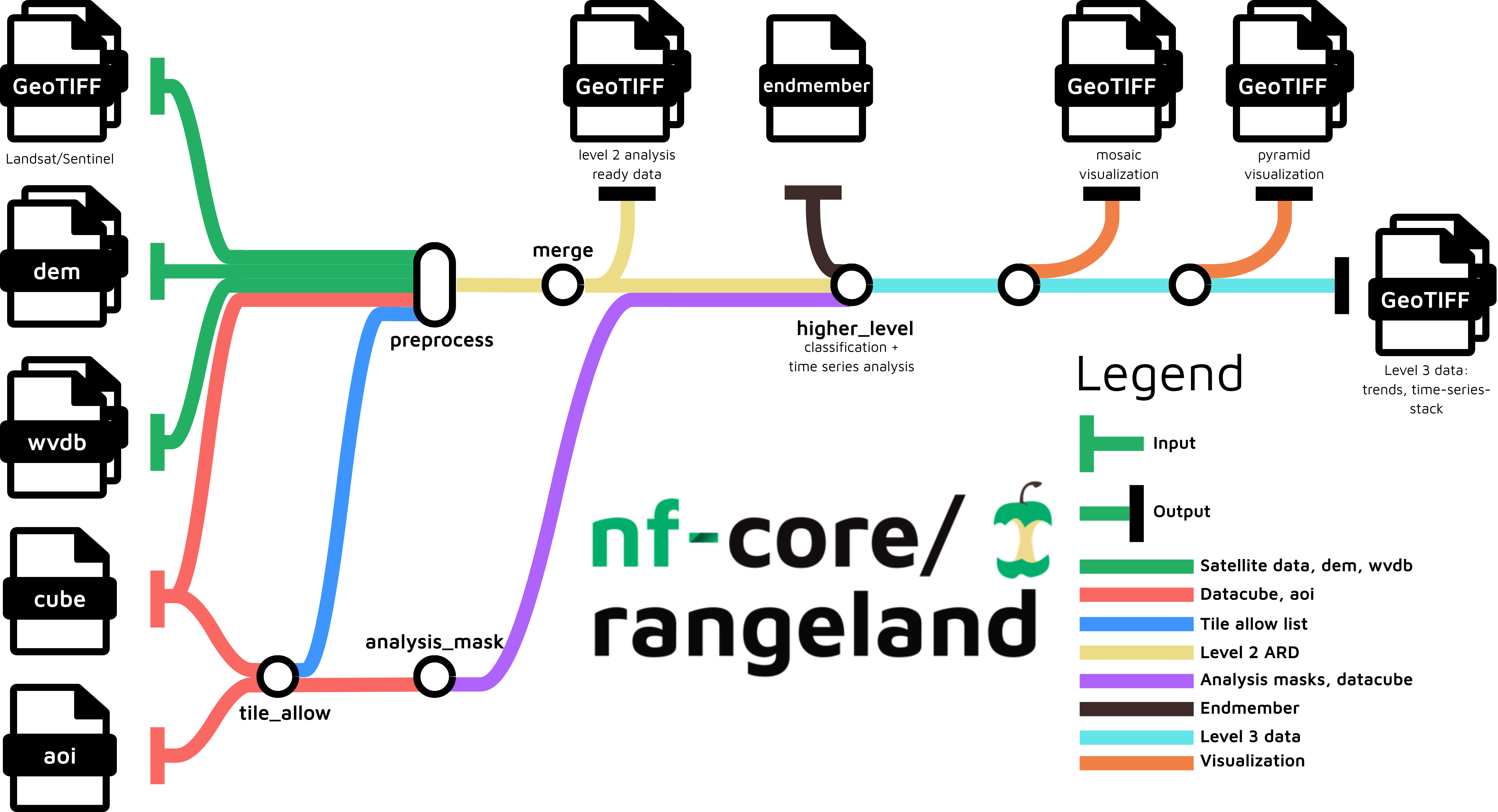nf-core/rangeland
Pipeline for remotely sensed imagery. The pipeline processes satellite imagery alongside auxiliary data in multiple steps to arrive at a set of trend files related to land-cover changes.
Introduction
nf-core/rangeland is a best-practice Earth Observation analysis pipeline for remotely sensed imagery. The pipeline processes satellite imagery alongside auxiliary data in multiple steps to arrive at a set of trend files related to land-cover changes. The main pipeline steps are:
- Read satellite imagery, datacube definition, area of interest definition (aoi) and optional inputs such as digital elevation model (dem), endmember definition and water vapor database (wvdb)
- Generate allow list and analysis mask to determine which pixels from the satellite data can be used
- Preprocess data to obtain atmospherically corrected images alongside quality assurance information (aka. level 2 analysis read data)
- Merge preprocessed data based on spatially and temporally overlap
- Time series analyses to obtain trends in vegetation dynamics to derive level 3 data
- Create mosaic and pyramid visualizations of the results
- Version reporting with MultiQC (
MultiQC)

Usage
If you are new to Nextflow and nf-core, please refer to this page on how to set-up Nextflow. Make sure to test your setup with -profile test before running the workflow on actual data.
To run, satellite imagery, datacube specification, and a area-of-interest specification are required as input. It is highly recommended to also provide data water vapor data, a digital elevation model and a endmember definition. Please refer to the usage documentation for details on the input structure.
Now, you can run the pipeline using:
nextflow run nf-core/rangeland \
-profile <docker/singularity/.../institute> \
--input <SATELLITE IMAGES> \
--data_cube <DATA CUBE> \
--aoi <AREA OF INTEREST> \
--outdir <OUTDIR>The following parameters should be added for optimal results:
--dem <DIGITAL ELEVATION MODEL> \
--wvdb <WATER VAPOR DATA> \
--endmember <ENDMEMBER SPECIFICATION>To enable spectral unmixing, and use the endmember file, the --indexes parameters should contain SMA, e.g.:
--indexes "SMA NDVI BLUE GREEN RED NIR SWIR1 SWIR2"See the usage documentation for more details on indexes.
Please provide pipeline parameters via the CLI or Nextflow -params-file option. Custom config files including those provided by the -c Nextflow option can be used to provide any configuration except for parameters; see docs.
For more details and further functionality, please refer to the usage documentation and the parameter documentation.
Pipeline output
To see the results of an example test run with a full size dataset refer to the results tab on the nf-core website pipeline page. For more details about the output files and reports, please refer to the output documentation.
Credits
The rangeland workflow was originally written by:
The original workflow can be found on github.
Transformation to nf-core/rangeland was conducted by Felix Kummer. nf-core alignment started on the nf-core branch of the original repository.
We thank the following people for their extensive assistance in the development of this pipeline:
Acknowledgements
This pipeline was developed and aligned with nf-core as part of the Foundations of Workflows for Large-Scale Scientific Data Analysis (FONDA) initiative.
FONDA can be cited as follows:
The Collaborative Research Center FONDA.
Ulf Leser, Marcus Hilbrich, Claudia Draxl, Peter Eisert, Lars Grunske, Patrick Hostert, Dagmar Kainmüller, Odej Kao, Birte Kehr, Timo Kehrer, Christoph Koch, Volker Markl, Henning Meyerhenke, Tilmann Rabl, Alexander Reinefeld, Knut Reinert, Kerstin Ritter, Björn Scheuermann, Florian Schintke, Nicole Schweikardt, Matthias Weidlich.
Datenbank Spektrum 2021 doi: 10.1007/s13222-021-00397-5
Contributions and Support
If you would like to contribute to this pipeline, please see the contributing guidelines.
For further information or help, don’t hesitate to get in touch on the Slack #rangeland channel (you can join with this invite).
Citations
If you use nf-core/rangeland for your analysis, please cite it using the following doi: 10.5281/zenodo.14679189
An extensive list of references for the tools used by the pipeline can be found in the CITATIONS.md file.
You can cite the nf-core publication as follows:
The nf-core framework for community-curated bioinformatics pipelines.
Philip Ewels, Alexander Peltzer, Sven Fillinger, Harshil Patel, Johannes Alneberg, Andreas Wilm, Maxime Ulysse Garcia, Paolo Di Tommaso & Sven Nahnsen.
Nat Biotechnol. 2020 Feb 13. doi: 10.1038/s41587-020-0439-x.
This pipeline is based one the publication listed below. The publication can be cited as follows:
FORCE on Nextflow: Scalable Analysis of Earth Observation Data on Commodity Clusters
